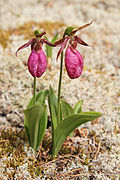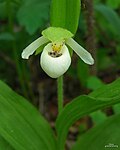| Cypripedium | |
|---|---|
 | |
| Showy lady's slipper ( Cypripedium reginae ) | |
| Scientific classification | |
| Kingdom: | Plantae |
| Clade: | Tracheophytes |
| Clade: | Angiosperms |
| Clade: | Monocots |
| Order: | Asparagales |
| Family: | Orchidaceae |
| Subfamily: | Cypripedioideae |
| Genus: | Cypripedium L., 1753 |
| Type species | |
| Cypripedium calceolus L., 1753 | |
| Synonyms [1] | |

Cypripedium is a genus of 58 species and nothospecies of hardy orchids; it is one of five genera that together compose the subfamily of lady's slipper orchids (Cypripedioideae). They are widespread across much of the Northern Hemisphere, including most of Europe and Africa (Algeria [2] ) (one species), Russia, China, Central Asia, Canada the United States, Mexico, and Central America. [1] [3] [4] [5]
Contents
- Characteristics
- Taxonomy
- Species and natural hybrids
- Subgenus Cypripedium
- Subgenus Irapeana
- Natural Hybrids
- Uses
- Conservation
- Awards
- References
- External links
They are most commonly known as slipper orchids, lady's slipper orchids, or ladyslippers; other common names include moccasin flower, camel's foot, squirrel foot, steeple cap, Venus' shoes, and whippoorwill shoe. An abbreviation used in trade journals is "Cyp." The genus name is derived from Ancient Greek Κύπρις (Kúpris), an early reference in Greek myth to Aphrodite, and πέδιλον (pédilon), meaning "sandal". [6]
In other regions of the world, other common names are prevalent. In China, it is referred to as Chinese : 杓兰, romanized: Biāo Lán, lit. 'Ladle orchid'.
Most of Cypripedium grow in temperate and subtropical climates, but some species grow in the tundra in Alaska and Siberia, which is an unusually cold habitat for orchids. Other species occur well into tropical areas such as Honduras and Myanmar. [1]
Some of the northern species can withstand extreme cold, growing under the snow and blooming when the snow melts. But, in the wild, some have become rare and close to extinction, due to an ever shrinking natural habitat and over-collection, people prizing the flowers for their beauty. Several species are legally protected in some regions. In the late 20th century, only a single known plant of Cypripedium calceolus survived in Britain.






























